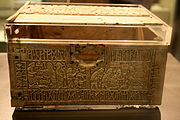Franks Casket
The Franks Casket (or the Auzon Runic Casket) is a small Anglo-Saxon whalebone chest from the eighth century, now in the British Museum. The casket is densely decorated with knife-cut narrative scenes in flat two-dimensional low-relief and with inscriptions mostly in Anglo-Saxon runes. Both identifying the images and interpreting the runic inscriptions has generated a considerable amount of scholarship. Generally reckoned to be of Northumbrian origin, it is of unique importance for the insight it gives into early Anglo-Saxon culture. This page collects and sorts all the photos in the category as at July 2010.
Front view. The front panel, which originally had a lock fitted, depicts elements from the Germanic legend of Wayland the Smith in the left-hand scene, and the Adoration of the Magi on the right. Wayland stands at the extreme left in the forge where he is held as a slave by King Niðhad, who has had his hamstrings cut to hobble him. Below the forge is the headless body of Niðhad's son, who Wayland has killed, making a goblet from his skull; his head is probably the object held in the tongs in Wayland's hand. With his other hand Wayland offers the goblet, containing drugged beer, to Bodvild, Niðhad's daughter, who he then rapes when she is unconscious. Another female figure is shown in the centre; perhaps Wayland's helper, or Bodvild again. To the right of the scene Wayland (or his brother) catches birds; he then makes wings from their feathers, with which he is able to escape.
In a sharp contrast of theme, the right-hand scene shows one of the commonest Christian subjects depicted in the art of the period. The Three Magi, identified by an inscription ("magi"), led by the large star, approach the enthroned Madonna and Child bearing the traditional gifts. A goose-like bird by the feet of the leading magus may represent the Holy Spirit, usually shown as a dove, or an angel. The human figures, at least, form a composition very comparable to those in other depictions of the period.
Back view. The rear panel depicts the Taking of Jerusalem by Titus in the First Jewish-Roman War and contains the inscription: her fegtaþ/ +titus end giuþeasu HIC FUGIANT HIERUSALIM /afitatores dom / gisl [below depictions of figures]
Which may be interpreted as: "Here fight / Titus and the Jews — here the inhabitants of Jerusalem flee / doom / hostage". At left in the upper register the Romans, led by Titus(?) in a helm with a sword, attack a domed building, probably the Temple of Jerusalem, in the centre. At right ("HIC FUGIANT HIERUSALIM") the Jewish population flee, casting glances backwards. In the lower register at left, a throned figure, probably Titus, announces the "doom" or fate of the defeated Jews, which as recounted in Josephus was to be sold into slavery. In the right hand scene, the "gisl" or slaves/hostages are led away.
The left panel depicts the mythological twin founders of Rome, Romulus and Remus, being suckled by a wolf lying on her back at the bottom of the scene. The same wolf, or another, stands above, and there are two men with spears approaching from each side. The inscription reads:
Right side: This, the Bargello panel, has produced the most divergent readings of both text and images, and no reading of either has achieved general acceptance. At left an animal figure sits on a small rounded mound, confronted by an armed and helmeted warrior. In the centre a standing animal, usually seen as a horse, faces a figure, holding a stick or sword, who stands over something defined by a curved line. At right are three figures; the two outer ones perhaps hold fast the one in the middle.
Lid: The lid as it now survives is too small. Leslie Webster has suggested that there may have been relief panels in silver making up the missing areas. The empty round area in the centre probably housed the metal boss for a handle.[8] The lid shows a scene of an archer, labelled Ægili, single-handedly defending a fortress against a troop of attackers, who from their larger size may be giants. A lady who is probably his wife or lover is also shown within the fortress. In Norse mythology, Egil is named as a brother of Weyland, who is shown on the front panel of the casket.

















